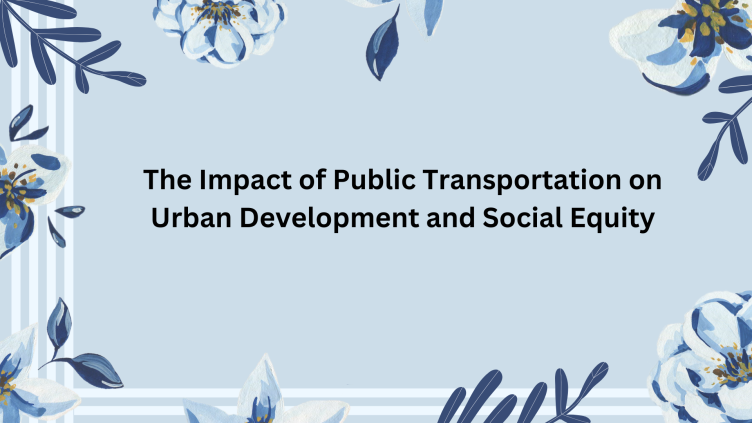Public transportation is often viewed as the lifeblood of urban areas, shaping the development of cities and fostering greater social equity. As urban populations continue to swell, the significance of robust and efficient public transport systems becomes ever more critical. In this article, we’ll dive deep into the transformative effects of public transportation on urban development and social equity, peppered with relevant, real-world examples that highlight its importance in today’s context.
The Role of Public Transportation in Urban Development
Public transportation is a cornerstone of urban planning, influencing everything from land use to economic growth. Here’s how:
- Land Use and Zoning: Public transportation systems, such as buses, subways, and trams, dictate the development of residential, commercial, and industrial zones. For instance, cities like New York and Tokyo have developed around their extensive subway systems, allowing for high-density living and the efficient movement of people. Transit-oriented development (TOD) is a key concept here, where residential and commercial spaces are designed to maximize access to public transport.
- Economic Growth and Job Creation: A well-connected city attracts businesses and talent. Take the example of London, where the introduction of the Crossrail project (now the Elizabeth Line) has spurred economic activity along its route, creating jobs and boosting property values. Public transportation not only connects people to jobs but also stimulates local economies by making areas more accessible.
- Environmental Sustainability: Reducing the number of cars on the road can significantly lower urban pollution levels. Cities like Copenhagen and Amsterdam, with their extensive public transport and cycling infrastructure, have set benchmarks for sustainable urban living. Public transportation reduces carbon footprints and encourages green urban spaces, promoting healthier living environments.
- Infrastructure Development: Investments in public transportation often lead to improvements in other urban infrastructures, such as roads, bridges, and pedestrian pathways. The High Line in New York City, initially a disused railway track, was transformed into a vibrant urban park, demonstrating how transportation infrastructure can be repurposed to enhance urban landscapes.
Public Transportation and Social Equity
Public transportation isn’t just about moving people from point A to point B—it’s a crucial tool for promoting social equity. Here’s why:
- Accessibility and Mobility: Public transportation provides mobility to those who might not have access to private vehicles, including low-income individuals, the elderly, and people with disabilities. For example, Curitiba in Brazil is known for its efficient and affordable bus rapid transit (BRT) system, which ensures that even the poorest residents can travel across the city affordably.
- Economic Opportunities: Access to reliable public transportation expands economic opportunities. In cities like Seoul, the extensive metro system connects distant neighborhoods to the city’s economic hubs, ensuring that all residents have access to job opportunities, education, and services.
- Reducing Transportation Costs: Public transportation can significantly lower the cost of living for urban residents. A study by the American Public Transportation Association (APTA) found that households in areas with good public transit save over $10,000 annually on transportation costs compared to those in car-dependent areas. This financial relief is especially crucial for low-income families.
- Health and Well-being: By reducing the need for car travel, public transportation can lower accident rates and promote physical activity. The introduction of bike-sharing programs in cities like Paris (Vélib’) and Washington D.C. (Capital Bikeshare) has not only made commuting healthier but also more equitable, providing affordable transport options for all.
Current Trends and Innovations in Public Transportation
With technological advancements and a growing emphasis on sustainability, public transportation is evolving rapidly. Here are some current trends:
- Smart Public Transportation: Cities are increasingly integrating technology to make public transport more efficient and user-friendly. Singapore, for instance, uses data analytics and AI to manage bus fleets and reduce waiting times. Apps that provide real-time updates and mobile ticketing are becoming commonplace, making public transport more accessible and convenient.
- Electric and Autonomous Vehicles: The shift towards electric buses and trains is gaining momentum, reducing the carbon footprint of public transport. China leads the way, with cities like Shenzhen operating entire fleets of electric buses. Additionally, autonomous vehicles, such as the driverless shuttles in Helsinki, are being piloted to enhance last-mile connectivity.
- Integrated Mobility Solutions: The concept of Mobility as a Service (MaaS) is transforming how people move within cities. By integrating various forms of transport—buses, trams, bikes, ride-shares—into a single accessible platform, cities like Helsinki and Vienna are making transportation seamless and more efficient.
- Sustainable Infrastructure: Investments in sustainable public transportation infrastructure are critical. Projects like the High-Speed 2 (HS2) in the UK aim to provide fast, reliable train services while promoting economic growth and reducing carbon emissions. Similarly, the expansion of metro systems in cities like Riyadh and Doha is aimed at reducing car dependency and promoting sustainable urban growth.
Real-World Examples of Impact
To understand the tangible impact of public transportation on urban development and social equity, let’s look at a few specific examples:
- Bogotá, Colombia: Bogotá’s TransMilenio BRT system has transformed the city’s transportation landscape, providing efficient and affordable transit to millions of residents daily. This system has significantly reduced travel times and pollution, making the city more livable and equitable.
- Portland, Oregon: Portland’s investment in light rail and streetcar systems has spurred urban regeneration and economic development. The city’s Pearl District, once a rundown area, has been revitalized with new housing, businesses, and cultural spaces, thanks in part to the accessibility provided by public transport.
- Hong Kong: The Mass Transit Railway (MTR) in Hong Kong is a stellar example of how public transportation can drive urban development. The MTR Corporation’s “Rail plus Property” model integrates real estate development with transit planning, generating revenue that is reinvested into the system, ensuring sustainability and affordability.
- Vienna, Austria: Vienna’s public transportation system is renowned for its efficiency and accessibility. The city offers an annual public transport pass for just €365, making it affordable for all residents and reducing car usage. This commitment to public transport has helped Vienna rank consistently as one of the world’s most livable cities.
Challenges and the Path Forward
While public transportation offers numerous benefits, it also faces challenges:
- Funding and Investment: Building and maintaining public transportation infrastructure requires substantial investment. Innovative financing models, such as public-private partnerships (PPPs) and value capture financing, can help bridge funding gaps.
- Political Will and Policy: Effective public transportation systems require strong political will and supportive policies. Policymakers must prioritize public transportation in urban planning and ensure that investments align with broader social equity goals.
- Inclusivity and Accessibility: Ensuring that public transportation systems are inclusive and accessible to all, especially marginalized communities, is paramount. This requires thoughtful planning and continuous engagement with diverse stakeholders.
- Technological Integration: Keeping pace with technological advancements and integrating them into public transport systems can be challenging. However, embracing technology is crucial for enhancing efficiency, user experience, and sustainability.
Conclusion
Public transportation is more than just a means of getting around—it’s a powerful catalyst for urban development and social equity. By providing affordable, efficient, and sustainable transit options, cities can enhance the quality of life for their residents, promote economic growth, and reduce environmental impact. As urban populations continue to grow, investing in and prioritizing public transportation will be essential for building resilient, inclusive, and thriving cities. Whether it’s through the adoption of new technologies, innovative financing models, or inclusive planning practices, the future of urban development hinges on the strength and equity of its public transportation systems.







